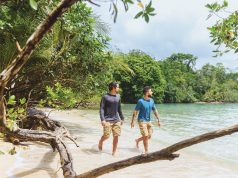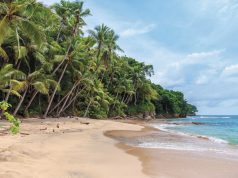In Panama you will find the best beaches in the world, either on the Pacific or the Atlantic coasts.
The word Panama means “Abundance of Fish and Butterflies” in indigenous language, but it can also be said in terms of tourism that our country has “Abundance of Islands” for its more than a thousand islands in both oceans. Whether large islands with treasures for their natural resources and infrastructure, or very small where you can only contemplate their wild beauty, tourists can explore several of them to choose their favorites.




Pacific islands
Contadora Island
Located in the Las Perlas archipelago, which is made up of 39 islands and 100 islets (many uninhabited), Contadora is a paradise worth discovering for its beautiful nature and historical setting. It has been visited by famous sailors in search of treasures, and characters from the Jet Set, both from the film world and royalty.
The largest pearl in the world – La Peregrina – was found on this island, and for this reason it is known as “The Pearl of the Pacific.” Among the most popular beaches are: Galeon, Las Suecas, Cacique, Ejecutiva and Playa Larga. There are approximately eleven beaches, but some are on private property.
It is a beach area with comfortable hotels and hostels, where you can practice water sports. Contadora Island can also be reached by ferry, which leaves from Isla Flamenco’s terminal locales at the Causeway or from the pier located in Punta Pacifica.
San Jose Island
It is the second largest island in Las Perlas Archipelago, and it is privately own. It has good road infrastructure among others; where you can get to hidden resorts and cabins with all the comforts, for those seeking luxury tourism.
As a historical fact, this island was used for chemical weapons tests. However, the place where these tests were made can’t be reach by tourists. Inspections have been carried out, and there have been no reports of injured guests or locals. The flight from Panama City takes about 20 minutes.
Taboga
Located in the Gulf of Panama, the famous Taboga Island is located just 12 nautical miles from the capital city. There are usually two boat trips a day to Taboga, and takes about 45 minutes. The boat crosses the Pacific entrance of the Panama Canal, providing passengers with stunning views of the city, the Bridge of the Americas, and different perspective of the ships and cargo vessels size waiting their turn to transit through the canal. .
Most visitors head towards Playa La Restinga, located near the pier. It is the one that has a sand bridge – when the tide is low – which connects with El Morro Island.
Iguana island
It is located off the eastern coast of the Azuero Peninsula. Declared a wildlife sanctuary in 1981, it is an enclosure where marine birds are protected, especially frigates, tropical fish, iguanas that sometimes invade the space of tourists looking for food and a large coral reef, the oldest in the gulf of Panama.
Isla Iguana is a kind of small Galapagos in Panama, which can be reached in a short boat trip departing from Pedasi. It is one of the points in the Pacific Ocean where you can see humpback whales between June and November.
Cebaco Island
It is the third largest in the country (surpassed by Coiba and Isla del Rey), which offers visitors a variety of activities such as: diving, fishing and boat rides, whale watching and hiking in the forests. Among its attractions is going up to the mountains at Cerro Hoya National Park.
To get there, you can leave from Malena or Torio beach, starting from Puerto Mutis (in the Gulf of Montijo, Veraguas); or from Santa Catalina beach.
Gulf of Chiriqui Islands
At the Chiriqui Gulf National Marine Park, the boats leave from Boca Chica town pier. Five minutes away by boat is Boca Brava Island, where there are places to stay.
Another recommended stop is Isla Coiba, the best known in the area. Isla Bolaños is an uninhabited place where you can be lucky to see everything from hawksbill turtles, dolphins to humpback whales. On Gamez Island you can practice snorkeling, diving and even fishing.
Isla Paridas is the largest in the marine national park, where you can see small cruise ships anchored. Likewise, you can see both inhabitants and tourists enjoying themselves on the shore of the beach under trees and palm trees, and from where you can hear the howler monkeys.
Atlantic Islands
Bastimentos Island
Located in the archipelago of Bocas del Toro and at only 10 minutes away from Isla Colon. One of the biggest attractions is its little crowded beaches on the north side of the island. There is a path that leads from the town of “Old Bank” to Playa Primera, known as “Wizard Beach”, a spectacular beach famous for its big waves and lonely atmosphere.
Another great attraction of Isla Bastimentos is Cayo Coral, a narrow channel located at the southern tip of the island that is considered one of the best snorkeling spots in the Bocas archipelago.
Cayo Zapatilla
Cayos Zapatilla is a group of two uninhabited islands surrounded by a coral reef, located east of Isla Bastimentos, in the Bocas del Toro archipelago. It is the ideal place to practice fishing and diving in its coral reefs and crystal clear waters. These mangrove islands feature fine sand and coconut trees that frame marine life, a haven of biodiversity.
Carenero Island
It is a small territory on the other side of the waters from Bocas town. The island has several hotels and a good spot for surfing. Some Carenero places are more developed than others. The side that borders Bocas town has several houses along the water. The other areas are mostly land for sowing.
Hotels in Carenero range from budget to luxurious. Some are in front of Isla Colon, while others are in isolated areas. Carenero has stores that offer some of the best local jewelry in the archipelago.
Escudo de Veraguas
Located on the Caribbean, one of the most unique islands in the world. Located in the Ngäbe – Bugle region, it is an island of just three hectares of surface, completely virgin, inhabited by indigenous people, and by a scarce handful of cabins that serve as a refuge for the fishermen who go through this area.
Entering the mangroves of this island is priceless. The lush vegetation that fills the peripheral view, is reflected in a translucent water, with a touch of turquoise by the corals in the background. On the walk you can see the pygmy sloth swimming among these mangroves in search of food. Many visitors are in awe of this destination, choosing it as one of their favorite places to return.
















